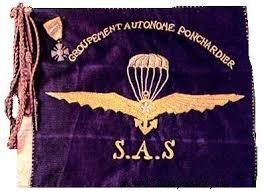
The Ponchardier commando is a disbanded unit of the French army formed by Admiral Henri Nomy at the end of the Second World War on the model of the British SAS. The battalion, initially intended to intervene in Indochina within the CLI (5th RIC) against the Japanese, was engaged against the Viet Minh in the Saigon region from the end of 45 to mid 46.
Creation and different denominations
January 1, 1945:creation of the naval air force paratrooper commando.
September 1, 1945:creation of the SAS Battalion.
February 15, 1946:SAS B becomes Groupement autonomous and reports directly to General Leclerc.
History and fights
On January 1, 1945, the parachutist commando of the naval aeronautics moved to the BAN Hyères Le Palyvestre. On February 22, 1945, he joined the Peterborough camp in order to receive his commando instruction and obtain the parachutist patent. On June 29, a detachment of 73 men embarked in Toulon and joined the Kurunegala camp in Ceylon on August 2.
The commando was integrated into Commander Huard's CLI1-5e RIC on September 1, 1945 and became the SAS Battalion. It then only includes the 3 commandos B1, B2 and B3.
Japan having capitulated, the unit was designated to fight the Viet Minh in Indochina and embarked on the Princess Beatrix and the battleship Richelieu for Saigon where it landed on October 3 and 4, 1945.
From October 12, the SAS B intervened in the liberation of the north of Saigon then from October 25 to December 27 it liberated the city of Mytho and the Vinh Long - Cantho - Tra Cu zone located south-west of the capital of the Cochinchina.
Back in Saigon, Ponchardier set up a fourth commando on January 22, the B4, from the strength of the light commando No. 2 (CL 2)2 which had just arrived in Indochina.
From January 25 to 30, the four commandos, aided by the 1er RFM and the RBFM3, intervened in the Bien Hoa region northeast of Saigon.
On February 16, 1946, in order to be parachuted into Hanoi during Operation Bir Hakeim, the commando became an independent group and depended directly on Leclerc. The operation is canceled at the last moment4.
On April 3, 1946, the group carried out the first drop of a parachute surgical antenna, made up of doctors Dumetz, Salinesi and Huc, and intended to rescue two seriously wounded from the III/43rd RIC in the Camau region south-east of Cantho5 .
From April 14 to May 1, the commando continued operations north of Saigon - An Loc Dong (14/4), Tan Uyen (17/4), An Son (1/5) - then to the northwest, from 22 May to June 1, around Tay Ninh near the Cambodian border. It is assisted in its operations by detachments of the 13th DBLE.
On August 28, 1946, the SAS B embarked on the liner Île-de-France and was disbanded on its arrival in Toulon on September 176. In December 1947 the French Navy set up another parachute commando which took the name of "Commando Hubert". The Hubert commando will become a unit of combat swimmers in 1953 by Claude Riffaud of Cdo François who joined Cdo Hubert in 1951.
Composition and framing
When it was created, SAS B included:a general staff, services and 3 commandos (B1, B2 and B3) each made up of 2 sections of 4 sticks7. A fourth commando, the B4, will be created in January 1946. The B1 commando is mainly made up of sailors and the other three of porpoises.
General Staff:
Second in Command:Lieutenant Brissot
Chief of Staff:Battalion Chief Dupuis
Information:Quennouelle
Doctor:Captain Bénédettini
Social worker:Séverine Ruellan
Chaplain:Second Lieutenant de la Martinière
Commando B1:Lieutenant Georges
Section Duray, then Schultz
Section Lavigne
Commando B2:Captain Lataste then Rouanet
Demonet Section
Boby Section
B3 Commando:Captain Orsini then Keser (acting)
Section Barthélémy and Keser (acting)
Section Saindrenan
Commando B48:captain Trinquier
Section Darchy
Section Baudemon
Currency
The motto of the unit, to life, to death, is inscribed on the insignia and on the pennant. It will be taken over by the 5th BCCP then by the 2nd BCCP commanded by battalion chief Dupuis, former chief of staff of the group.
Insignia

The SAS B insignia was designed in England at the beginning of 1945 by Serges Pâris. The geometry of the insignia is a dark blue kite, with an open hand in its center and a dagger, symbol of the commandos, pointing downwards. The unit's motto is inscribed on either side of the blade.
Pennant
The unit pennant includes:

on one side, the naval air parachute certificate with the inscriptions SAS, below, and Groupement autonome Ponchardier above.
on the other side, the motto of the unit to life and death and insignia design:an open hand crossed by a dagger pointing downwards.
Decorations
The pennant is decorated with the Croix de guerre 1939-1945 with two palms for his two citations to the order of the Army:
April 30, 1946:1st citation signed by General Juin and presented in the presence of General Leclerc in Saigon.
October 7, 1947:2nd citation signed by President of the Council Paul Ramadier
The pennant and veterans of SAS B wear the fourragère in the colors of the Croix de Guerre 1939-45.
Leaders
Lieutenant Commander Pierre Ponchardier
